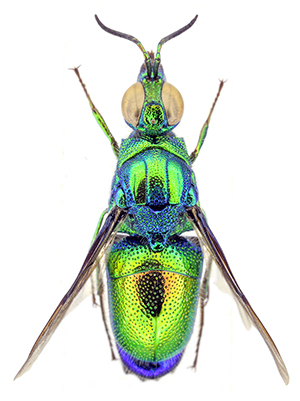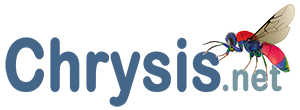Last updated on November 28th, 2023
 From: Kimsey L.S. & Bohart R.M., 1990 (1991) – The chrysidid wasps of the world. Oxford University Press, ix-652 pp.
From: Kimsey L.S. & Bohart R.M., 1990 (1991) – The chrysidid wasps of the world. Oxford University Press, ix-652 pp.
Synonymy
Stilbum Spinola 1806:9. Type: Chrysis calens Fabricius 1781:455 (=Chrysis cyanura Forster 1771:89). Desig. by Latreille 1810:437.
Generic diagnosis
Large species, length 7 (exceptional) to 22 mm; face and scapal basin quite narrow (LID less than length of scape plus pedicel), finely to moderately coarsely cross-ridged; F- I 1.5-2.0 times as long as broad; TFC a weak callosity or an inverted crescent connected to a carina circling above mid ocellus; malar space 2-4 MOD; mandible essentially without inner tooth; subantennal space 4-5 MOD; mid ocellar area raised, completely defined except sometimes anteriorly and posteriorly; mid ocellus lidded; genal carina about 0.5 MOD from eye; subgenal area not defined; pronotum much shorter than scutellum, medial groove present and broad anteriorly, lateral depression deep and partly edged above by carina; fore wing marginal cell broadly open, Rs, if extended along wing fold, ending just anterior to wing tip, discoidal cell complete; bind wing venation relatively complete, Rs as in fore wing, M + Cu and anal veins present; metanotum with long oval cup-shaped projection; mesopleuron with deep scrobal sulcus, lower mesopleuron with three teeth, lowest one large, upper mesopleuron with medial vertical polished area like one on metapleuron; propodeal angle stout, apical point projecting posteriorly; T-I sharply rounded and briefly welted anterolaterally, short medially; T-II long, medial ridge polished, posterolateral corner acute and sharp; T-III with short strong prepit ridge overhanging well-developed pit row, narrow apical rim four-dentate; female T-V with heavily sclerotized ridges and dentate laterally; T-VI with heavily sclerotized sharp apical tooth; S-II Spots rounded, 4-5 MOD apart. Male terminalia: S-VIII subtriangular with prominent mediobasal apodeme, gonocoxa triangular and membranous toward apex, digitus and cuspis slender.
Hosts
Stilbum parasitizes various mud-nesting eumenids (Delta) and sphecids (Sceliphron) (Berland and Berland 1938, Móczár 1961). In addition, Mocsáry (1889) reported Chalicodoma as a host of cyanurum.
Distribution
This genus is widespread in the warmer parts of the Old World, occurring throughout Africa, the southern Palearctic, Oriental, and Australian Regions.
Discussion
Variability in the colour of the widespread cyanurum has led to the proliferation of species and subspecies names. Linsenmaier (1959) listed six species and eight sub-species, whereas we prefer to treat just three species. In general we agree with Zimmermann (1937), who placed all names under two species, cyanurm and viride. We are recognizing a third species, chrysocephalum, from the Philippines. The colour range of cyanurum is considerable, from green to blue to coppery or coppery-red and blue (calens colour form). However, colour pattern does seem to have some species significance. As Linsenmaier (1959) pointed out, viride is unique in having T-III (although coppery tinged) the same green base colour as T-I-II. In other Stilbum, with rare exceptions, the base colour of T-III is a darker blue to purple than that of T-I-II. In chrysocephalum the frons, gena, and vertex are coppery red in contrast to the green-blue-purple of the rest of the body. Also, in the last species the mid ocellar area is less elevated than in the other two, and only irregularly welted below rather than carinate. The great size differences observed in Stilbum presumably relate to host size. An apparent relationship between Stilbum and Stilbichrysis is discussed under that genus.
European species
Copyright, Authorship, and Ownership statements
All text and images of this page are copyright ©️ Chrysis.net unless otherwise stated - please see individual cases for authorship and copyright details. The specimens pictured are from the authors' or other collaborators' personal collections and from the collections of various museums. Unless otherwise specified, the whole content of this web site is for personal, non-commercial, scientific, and educational purposes given proper accreditation to the page from which they were derived are provided, and under Chrysis.net Terms and Conditions.
For citation purposes
Agnoli G.L. & Rosa P. (2025) Genus Stilbum Spinola, 1806, in: Chrysis.net website. Interim version 28 December 2025, URL: https://www.chrysis.net/database/genus-stilbum/.




